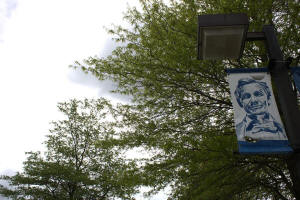Tuition, fees rising at Illinois universities as state funding lags
inflation pace
[April 29, 2025]
By Bridgette Fox
SPRINGFIELD – The cost to attend state universities has been rising, and
some institutions have said they’ll have to continue pushing the brunt
of state budget shortfalls onto students and families if there isn’t a
change.
Data from the Illinois Board of Higher Education, which oversees public
universities, shows university income has had to make up for the steady
loss of funding from the state since around fiscal year 2009 as compared
to inflation.
Since that point, state investment hasn’t kept up with inflation, and
tuition and fees have risen steadily despite the fact that Gov. JB
Pritzker’s administration has regularly increased higher education
funding. The fiscal year 2026 proposed budget includes a 3% increase for
higher education in the general fund for operating costs – which is
about the same as the rate of inflation.
The cost of tuition and fees for statewide undergraduates on average has
risen 10% higher since FY09 than if it had simply kept pace with
inflation. For graduate students, that discrepancy is 16%.
The University of Illinois Chicago is the only school that has seen
tuition and fees for both graduate and undergraduate students grow more
slowly than inflation.
Administrators from many of the states’ universities have said they’re
holding out hope that a new funding formula, contained in Senate Bill 13
and House Bill 1581, will alleviate some financial burden.

The formula as it is currently proposed would use data from the Illinois
Board of Higher Education to determine how much money public
universities would need on a per-student basis. University officials
said the current system for allocating funds to universities isn’t quite
as clear about determining why one university gets more funding than any
other.
During a Senate appropriations hearing last week, Sen. Michael Halpin,
D-Rock Island, and Northern Illinois University President Lisa Freeman
each supported a data-based funding formula over the current method.
Administrators for almost every public state university who have spoken
to the same committee have said they need to keep asking for more money
than what the governor proposed in order to fend off tuition and fee
increases.
“We understand funds are more constrictive this year than in the recent
past,” said Eastern Illinois University President Jay Gatrell during the
committee meeting. “That said, we do have bills to pay, and we only have
two real sources of revenue: state appropriations, which cover roughly
one-third of our operating costs, and student tuition and fees, which
cover the remaining two-thirds.”
During fiscal year 2003, that breakdown was flipped – the state covered
more than two-thirds of universities’ operating costs.
“No university really wants to increase tuition cost,” said Corey
Bradford, interim president of Governors State University in an
interview. “We do it in order to balance our budgets.”
[to top of second column]
|

A banner of Abraham Lincoln hangs from a light post at the
University of Illinois Springfield. UIS is another school that has
seen an increase in tuition and fees. (Capitol News Illinois photo
by Bridgette Fox)

The proposed funding formula hasn’t made its way through either chamber
yet, though legislators generally have ways of moving major legislation
beyond stated bill deadlines, up until end-of-May adjournment. If it
doesn’t move, universities will continue being appropriated funds by
standards set from years past.
“Even if there are differences in dollars per FTE (full time equivalency
student) after we were to implement this formula, at least those
differences would be grounded in this data in the program,” Halpin said.
“Right now, we have these discrepancies, but there’s … not necessarily a
hard data point, or set of data points, to justify it.”
MAP grants
In his February budget plan, Pritzker proposed increased funding of $10
million for Monetary Award Program grants for students to use toward
tuition and fees, matching the same increase he made for the previous
year’s budget.
MAP grants can go to any student who’s eligible for financial aid across
the state. Pritzker’s proposed increase would make the new MAP grants
pool total $721.6 million – up from $400 million when he was first
elected in 2019.
However, MAP grants don’t directly fund universities the same way money
from the general fund does.
“MAP goes to all colleges,” Bradford said. “Community colleges, private
colleges, it doesn’t all come to public universities.”
University building projects
Sen. Chapin Rose, R-Mahomet, asked every university president during
recent committee hearings if their schools had received any funding for
deferred maintenance projects on campuses for the current fiscal year.
Rose said no one has said “yes” yet.
“I think we’d like to know before we get to next year’s budget how we’re
spending last year’s budget,” Rose said. The current budget year
concludes on June 30.
Ginger Ostro, IBHE’s executive director, said the board is working with
universities and meeting with them and the Illinois Capital Development
Board to maintain lists about deferred maintenance projects and make
sure funding is distributed.
Capitol News Illinois is
a nonprofit, nonpartisan news service that distributes state government
coverage to hundreds of news outlets statewide. It is funded primarily
by the Illinois Press Foundation and the Robert R. McCormick Foundation.
 |